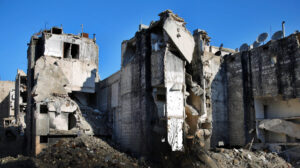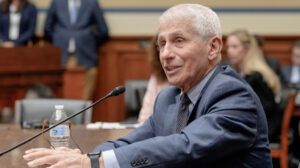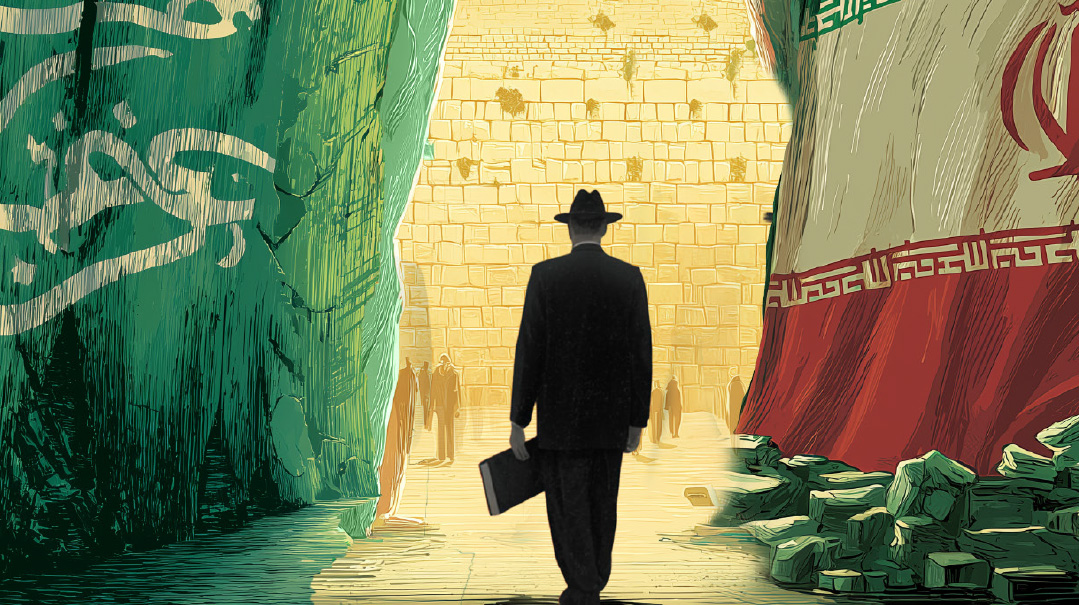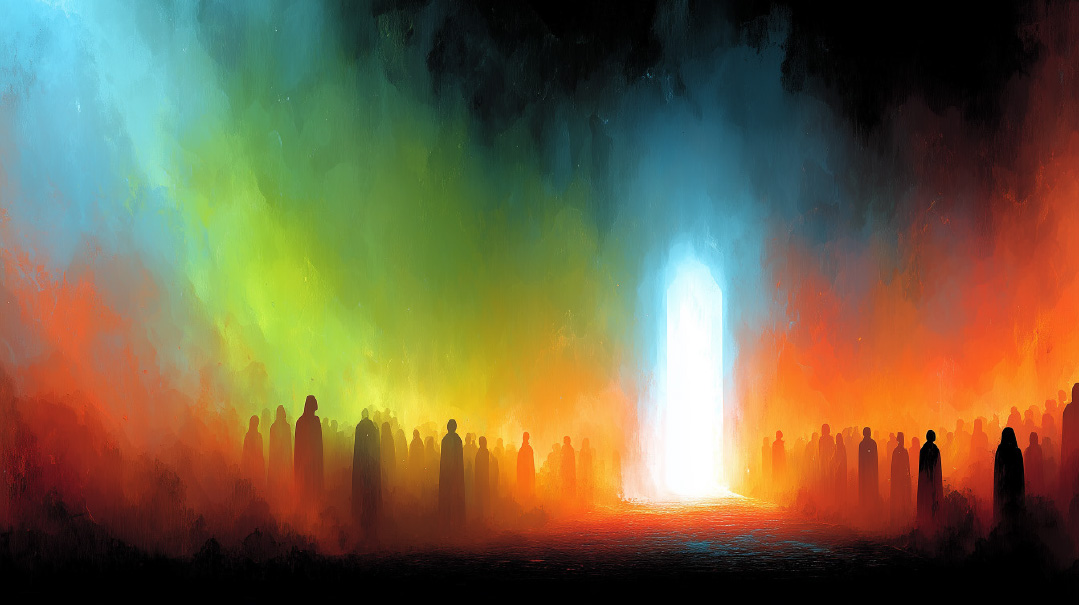Our Storm, My Boat

Taking stock, one year into COVID
Item one: Two siblings, ages five and three, play their own new make-believe game called COVID-19 testing. Each inserts a spoon handle into the nostril of the other and says in a gentle, apologetic voice, “Oh, I’m sorry, honey.” It’s a sign of the times.
Item two: A little girl gently holds her doll close, and places an imaginary thermometer on its head, declaring to her mommy, “I’m checking her temperature so she can go to school.” How sweet. It’s a sign of the times.
Item three: A harried balabos is running late for minyan as some surprises vie for his attention at home. He is torn between going to shul anyway, to catch some semblance of tefillah b’tzibbur, or just stay home and daven alone. After all, he’s been doing it for months during lockdown and seemed none the worse for wear, gaining a few extra minutes at home, maybe even with coffee. He could proceed into his underground bunker (a.k.a. home office) with a little more serenity. Sign of the times?
Item four: A devoted masmid who hasn’t missed his daf yomi shiur in two cycles starts to doze off after a busy day. The dynamic maggid shiur and devoted attendees are about to assemble for that day’s daf. He thinks to himself, “Maybe I’ll just Zoom in tonight, it worked for Berachos and Shabbos. The oilem will understand.” Sign of the times?
While items one and two are whimsical, numbers three and four are a bit more unfortunate.
Let’s face it. We have all been through a lot, for almost an entire year. Even the most pessimistic among us never foresaw any of this. Nobody needs to be reminded of the disruptions to our daily lives and our religious observance. Immeasurable damage has been done to staples of our existence, our schools and our shuls. Those who are less self-sufficient, whether students or balabatim, have suffered the most. We are worn out, physically and emotionally. Can you blame our friends for having let their feet off the gas pedal a bit, even as their precious minyan and learning b’rabim takes a hit?
But we are witnessing changes in attitude and in our resolve to sweat it out. And we need to empower ourselves going forward.
I often remind myself of the powerful words of Rav Chaim Volozhiner in Nefesh HaChaim on the maamar Chazal at the end of Maseches Sotah that paints a gloomy picture of the world preceding the arrival of Mashiach, ending with the words, “On whom do we have to rely? [Only] our Father in Heaven.” Simply understood, the baraisa is giving us a mandate: throw up our hands in desperation and realize Hashem is our only hope.
The Nefesh HaChaim, however, interprets this phrase not as a solution, but rather part of the problem. People have a tendency to sarcastically say, “Only Hashem can help,” as if to express that there truly is no hope at all. This is precisely what we should not be saying; rather, we should express with optimism, emunah, and bitachon that Hashem is our only source of yeshuos. We have to sincerely mean it, and if things are not going as we hoped, we must redouble our emunah, as the pasuk instructs us, “Kavei el Hashem, chazak... v’kavei el Hashem.” Instead of dwelling on the misfortune that has befallen us all, the time has come to change our focus and perhaps adopt a different perspective.
There is a midrash in the beginning of parshas Shemos that begs for clarification. Chazal darshen the name of each shevet “al sheim hageulah,” corresponding to their ability to bring about the exodus. For example, Reuven is so called because “ra’isi es ani ami,” he caused Hashem to see the dire straits of His nation. Shimon’s name alludes to “vayishma na’akasam,” He heard their screams. Yehudah caused us to give eventual thanks and praise to Hashem. And so on. The question here is that parshas Vayeitzei describes completely different origins of the Shevatim’s names as they were given by the Imahos. How do we reconcile this?
Rav Moshe Wolfson shlita, the mashgiach of Yeshiva Torah Vodaath (Sefer Emunas Itecha), explains that when a name is given, there is a basic interpretation of its meaning; however, it contains many other connotations, of which we may be totally unaware. The child’s personality and potential, as represented by these other connotations, may lie dormant in him for years, until some new life event brings them to the fore.
When the Shevatim descended into galus Mitzrayim, they already had “kochos,” abilities and energies, embedded deep inside that they would need to survive and even thrive in exile. They themselves may have been unaware of these kochos until they were called upon to rise to the occasion and utilize them. This is the message of the midrash. These potential abilities had indeed been inside them the entire time, waiting to be brought out specifically at this new stage of life and history.
This very relevant message should serve as a source of strength for us in these times we are living through today. In the current dizzying swirl of events, we are all being called upon to bring out qualities we may have never realized we possessed.
Instead of dwelling on the world that was and pining for an existence that may never return, perhaps we should come to terms with the new reality and uncover the hidden kochos we have been harboring all along.
I recall as a bochur learning in Bnei Brak back in the ’80s, hearing yeshivishe raid that Rav Shach wanted to elevate Rav Aharon Leib Steinman (then an obscure figure to the world, but hardly a secret to the locals) to take a lead role in public affairs. The Rosh Yeshivah L’tze’irim, as Rav Steinman was known as then, wanted no part of it. He felt his role was to mold young talmidim with great care, ensuring a solid foundation for Klal Yisrael. Yet years later, when the time came, it was Rav Aharon Leib who stepped in to fill the leadership vacuum. It was a new era, and time to utilize his own kochos of hanhagas haklal.
In truth, we do not need to look at gedolei hador to see how to take stock of abilities and talents and redirect them. L’havdil, the secular world has its own models for reinventing potential for society’s betterment. Whoever thought Ford would reconfigure its assembly lines to manufacture thousands of ventilators? I highly doubt the talented individuals who designed the equipment decades ago ever imagined it would be used to save the lives of people who could barely breathe. How many other individuals in textile or paper industries were burning the midnight oil to try to produce masks or other PPE (a new addition to the lexicon) to protect the world from the new scourge known as COVID-19? For some it was a matter of saving humanity, for others their own livelihoods. But in one instance after another, new potentials were being realized, and sometimes with greater successes than before.
Let us return to the friends we referenced at the outset. Without a doubt, a number of people’s adherence to tefillah b’tzibbur and talmud Torah b’rabim has taken a big hit, to name just two victims of the pandemic. Bedieveds have become l’chatchilahs, some for longer than ever expected. Instead of longing for the old normal, which we may not see for a long time, we should perhaps focus on reinventing ourselves for the better. We never lack for challenges, but the ways we choose to deal with them can be defining moments, and show us what we are really made of.
A very close friend, highly successful in his chosen career, shared an exchange he had with a gentile colleague. After bemoaning the current climate, the other man commented, “Well, we’re all in the same boat.”
My friend quickly retorted, “Not true, we are all in the same storm. Which boat you choose to navigate it with is your choice.”
This particular balabos — a misnomer, for he is a very prominent talmid chacham in his own right — had decided during the lockdown to commit his chiddushei Torah to print. That was his boat.
Another individual, a retired shul rav, revived his old membership email list and sent weekly drashos to his virtual congregants. The sense of reconnection when everyone was so lonely provided not only nostalgia but a source of chizuk for many of his alumni.
During the early days of COVID-19, which coincided with Yom Tov, singles young and old were particularly hit hard. Many answered the call and took the initiative to reach out, establishing closer relationships that have endured beyond the original crisis. These wonderful “givers” were afforded the opportunity to see a side of themselves that perhaps had not been developed previously.
A couple of businessmen spark a massive initiative that transforms the frum community into the largest source of convalescent plasma in the country.
A veritable fleet of corona success stories.
Rav Aharon Soloveichik ztz”l, an icon of the Chicago community, suffered a debilitating stroke while at the peak of his career as a marbitz Torah, traveling between Chicago and New York to deliver shiurim in RIETS. I recall the first time I saw him struggling to don his tefillin (he insisted on doing it himself), a long and arduous process. The look of devotion to the mitzvah was indescribable.
Only at his levayah did I get a better appreciation of the type of eved Hashem he was, when his son shared the following quote from his father: “Until now my purpose was to serve Hashem with a healthy body, now my job is to serve him this way.”
What a lesson in how to stare adversity in the face and take it on with bitachon and emunah shleimah. This was the boat in which he chose to ride out his personal storm.
We, too, need to dig deep inside ourselves and realize our latent abilities in our new chapter of galus, in order to navigate this storm with success. And what we might think is a big sacrifice on our part may actually turn out to be a great source of brachah.
The legendary Ponevezher Rav, carrying the burden of his institutions on his broad shoulders, approached a certain potential donor, without any success. Despite the man’s largesse, he had no interest in supporting Torah, and even told the Rav that parting with his money was akin to ripping out a piece of his flesh. Undaunted, the Rav asked the man if he was familiar with the ideal of being moser nefesh for Torah, citing various examples throughout Shas. Incredibly, the wealthy man challenged the Rav and asked why he himself wasn’t moser nefesh.
The Rav replied that indeed he was, but not in the sense this man may have expected to hear. “Do you not think I could give shiurim like Rav Shmuel Rozovsky and Rav Dovid Povarsky [the roshei yeshivah of Ponevezh]? I gave that all away so I could devote my life to the perpetuation of Torah.”
He quoted the words of the Rambam in Peirush Hamishnayos, “If not for those who appear crazy [mishtag’im], the world could not exist.” Although the Rambam is really discussing merchants who travel the world buying and selling goods for the benefit of the world, by the same token, those who sacrifice their ruchniyus are likewise mishtag’im and hold up the world as well.
The Rav left with a very generous donation. At the Rav’s levayah, Rav Chaim Shmuelevitz ztz”l reiterated the point: the Rav could have been the Rabi Akiva Eiger of his generation, and he gave it all away for us.
We can decide for ourselves how crazy we want to make ourselves for kiyum ha’olam. Certainly our incredibly devoted Hatzalah members, doctors and nurses, and chesed askanim can proudly wear the badge of mishtag’im and pillars of the world. But they are not the only ones. Everyone contains within himself hidden abilities and talents that may be mekayeim even one solitary olam, one person. It could be a needy neighbor, a lonely single, a child who is suffering from lack of structure and regular learning. Those who seize the opportunity to be a big brother or sister to a needy youngster can save a neshamah forever. It could be life changing, for both of them.
It has been a difficult storm to endure. Let’s get in our boats and navigate as best as we can. We might even get a little meshugeh in the process, in this crazy world Chazal described as Ikvesa d’Meshicha. Maybe these are finally the last signs of the times. We can only put up our hands in sincere tefillah and declare, “We have nothing to lean on except Avinu shebaShamayim.”
Rabbi Plotnik,a talmid of the yeshivos of Philadelphia and Ponovezh, has been active in rabbanus and chinuch for 25 years and currently serves as ram in Yeshivas Me’or HaTorah in Chicago.
(Originally featured in Mishpacha, Issue 851)
Oops! We could not locate your form.












